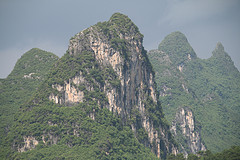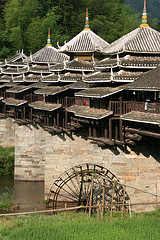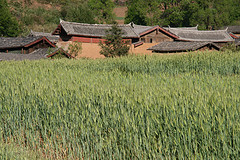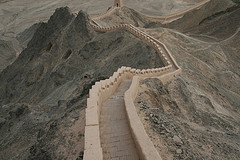Guangxi: Scenery, Villages and a Whole Lot of Bridges
Sunday, May 31st, 2009With some more time off between Guangzhou sojourns, we set out again last week to discover some more of this enormous country, beginning with the next province west of Guangdong (wide east): Guangxi (wide west).
 Having spent considerable time debating the pros and cons of visiting Yangshuo, a backpacker mecca village in Guangxi, we decided to go and I’m glad we went, if only so that we won’t die wondering. Yangshuo is indeed completely overrun by tourism, but as always in China this has its benefits (principally: English speakers; non-Chinese food). There are a few touts around and a bit of hassle, but nothing close to the Morocco/India level. As for the main reason people go there in the first place, I imagine that if you’ve never seen karst scenery before, the countryside around Yangshuo would be pretty mind-blowing. But if you’ve already been to all of Halong Bay/Krabi/Palawan/Northern Laos/Nimh Binh within the last 18 months, Yangshuo drops a bit on the scale from spectacular to merely very nice. We rented bicycles one day and cycled around the countryside to the Dragon Bridge, which was itself kind of disappointing, though the scenery around the Yulong River was very pleasant. Beyond this, we spent the rest of our time devouring bacon and eggs, veggie burgers and lasagna, recovering from the intensity and fallout of our last few days in Guangzhou and discussing a favourite topic: our future beyond backpacks and buses. I also spent a fair bit of time reflecting on the life of my ‘Oma’ (the Dutch word for grandmother), who died a few days earlier at the ripe old age of 90 after a full and feisty life.
Having spent considerable time debating the pros and cons of visiting Yangshuo, a backpacker mecca village in Guangxi, we decided to go and I’m glad we went, if only so that we won’t die wondering. Yangshuo is indeed completely overrun by tourism, but as always in China this has its benefits (principally: English speakers; non-Chinese food). There are a few touts around and a bit of hassle, but nothing close to the Morocco/India level. As for the main reason people go there in the first place, I imagine that if you’ve never seen karst scenery before, the countryside around Yangshuo would be pretty mind-blowing. But if you’ve already been to all of Halong Bay/Krabi/Palawan/Northern Laos/Nimh Binh within the last 18 months, Yangshuo drops a bit on the scale from spectacular to merely very nice. We rented bicycles one day and cycled around the countryside to the Dragon Bridge, which was itself kind of disappointing, though the scenery around the Yulong River was very pleasant. Beyond this, we spent the rest of our time devouring bacon and eggs, veggie burgers and lasagna, recovering from the intensity and fallout of our last few days in Guangzhou and discussing a favourite topic: our future beyond backpacks and buses. I also spent a fair bit of time reflecting on the life of my ‘Oma’ (the Dutch word for grandmother), who died a few days earlier at the ripe old age of 90 after a full and feisty life.
 After a couple of days in Yangshuo, it was time to return to the ‘real China’ of remote villages, survival Mandarin and questionable food. We went first to Huangyao, a gorgeous traditional village with no other foreigners and only a few Chinese tourists (though this is bound to change). Huangyao is everything a Chinese village should be: a peaceful place of cobblestone alleys, stone bridges, tiled rooftops and yellow lanterns, where old people sit in their doorways and watch the world go by, and young children smile and say hello to the strange foreigners. Within half an hour of arriving we’d been invited into an old cobbler’s very basic house to drink baijiu (home-made alcohol) out of empty toothpick jars and eat peanuts with soy sauce. Though the baijiu wasn’t too nice and the cobbler didn’t speak a word of English, it was a beautiful, heartfelt welcome and it set the tone for a really enjoyable overnight stay. We slept in the only inn in the old village and the next day they gave us zhongzi (rice cakes) to eat for the start of the three-day dragon boat festival.
After a couple of days in Yangshuo, it was time to return to the ‘real China’ of remote villages, survival Mandarin and questionable food. We went first to Huangyao, a gorgeous traditional village with no other foreigners and only a few Chinese tourists (though this is bound to change). Huangyao is everything a Chinese village should be: a peaceful place of cobblestone alleys, stone bridges, tiled rooftops and yellow lanterns, where old people sit in their doorways and watch the world go by, and young children smile and say hello to the strange foreigners. Within half an hour of arriving we’d been invited into an old cobbler’s very basic house to drink baijiu (home-made alcohol) out of empty toothpick jars and eat peanuts with soy sauce. Though the baijiu wasn’t too nice and the cobbler didn’t speak a word of English, it was a beautiful, heartfelt welcome and it set the tone for a really enjoyable overnight stay. We slept in the only inn in the old village and the next day they gave us zhongzi (rice cakes) to eat for the start of the three-day dragon boat festival.
 After a second overnight stop in Guilin, the next day we journeyed north to see the covered Chenyang Bridge, which was built by villagers in 1916 and is the most celebrated of around 100 ‘wind-and-rain’ bridges in the area. It was overcast when we arrived (as it always is in these parts at this time of year, as we’re discovering) but at one point the afternoon sun emerged from its blanket of clouds, bathed the bridge in glorious sunshine and had my shutter working overtime. The region around the bridge is a picturesque place filled with small villages, drum towers, water wheels to irrigate rice fields and, of course, more wind and rain bridges; we saw seven more on a 10km bike ride the next day, and another from the window of the train the next night, but none of them could compare with the first.
After a second overnight stop in Guilin, the next day we journeyed north to see the covered Chenyang Bridge, which was built by villagers in 1916 and is the most celebrated of around 100 ‘wind-and-rain’ bridges in the area. It was overcast when we arrived (as it always is in these parts at this time of year, as we’re discovering) but at one point the afternoon sun emerged from its blanket of clouds, bathed the bridge in glorious sunshine and had my shutter working overtime. The region around the bridge is a picturesque place filled with small villages, drum towers, water wheels to irrigate rice fields and, of course, more wind and rain bridges; we saw seven more on a 10km bike ride the next day, and another from the window of the train the next night, but none of them could compare with the first.
We’re going to spend the rest of our time before our next stop in Guangzhou in the province of Hunan, the birthplace of Mao Zedong and a region rarely visited by foreigners. Luckily, Wendy is listening to Chinese-learning podcasts as I type…


